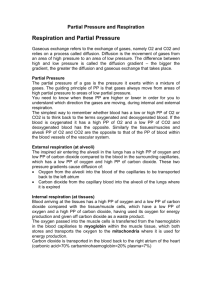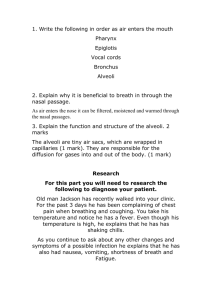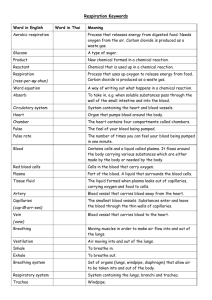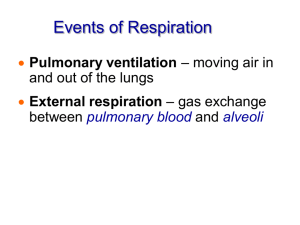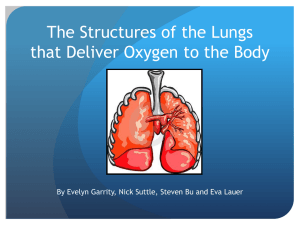Respiratory System Anatomy Medical Terminology 1. Nose
advertisement
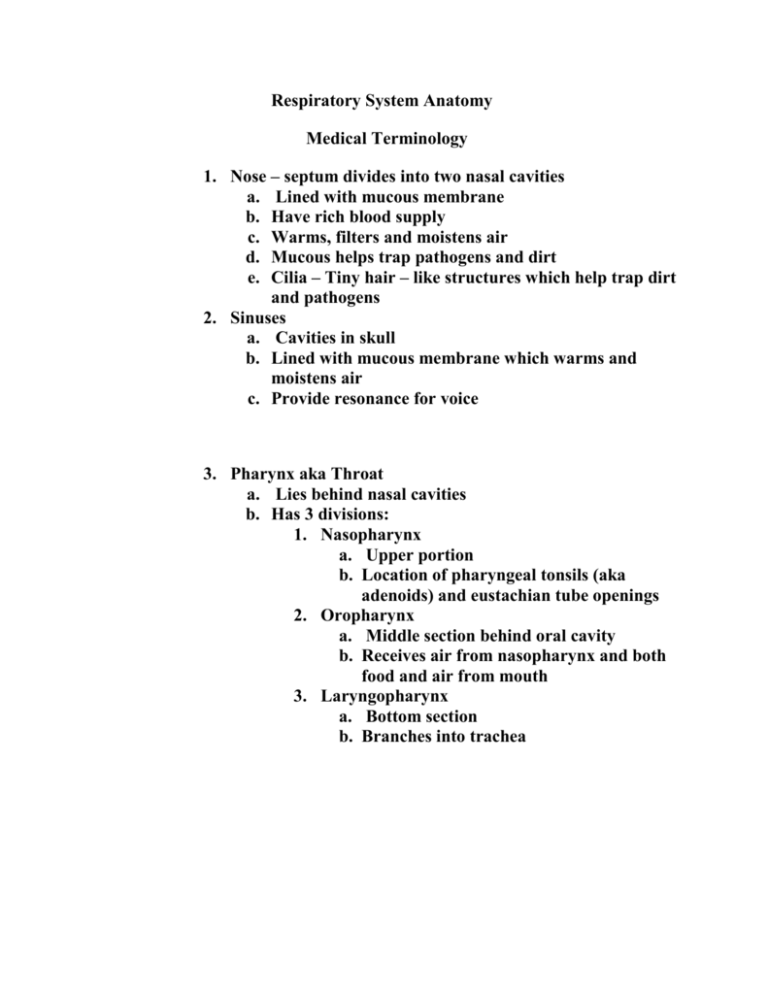
Respiratory System Anatomy Medical Terminology 1. Nose – septum divides into two nasal cavities a. Lined with mucous membrane b. Have rich blood supply c. Warms, filters and moistens air d. Mucous helps trap pathogens and dirt e. Cilia – Tiny hair – like structures which help trap dirt and pathogens 2. Sinuses a. Cavities in skull b. Lined with mucous membrane which warms and moistens air c. Provide resonance for voice 3. Pharynx aka Throat a. Lies behind nasal cavities b. Has 3 divisions: 1. Nasopharynx a. Upper portion b. Location of pharyngeal tonsils (aka adenoids) and eustachian tube openings 2. Oropharynx a. Middle section behind oral cavity b. Receives air from nasopharynx and both food and air from mouth 3. Laryngopharynx a. Bottom section b. Branches into trachea 4. Larynx (aka voice box) a. Contains vocal cords b. Epiglottis 1. Leaf - like piece of cartilage 2. Closes opening into larynx during swallowing 3. Prevents food and liquids from entering respiratory tract 5. Trachea (aka windpipe) a. Tube extending from larynx to center of chest b. Carries air between pharynx and bronchi 6. Bronchi a. Two divisions of trachea near center of chest b. Carries air from trachea to lungs c. In lungs bronchi divide into smaller and smaller bronchi called bronchioles 7. Alveoli a. Air sacs which resemble a bunch of grapes at end of bronchioles b. Contain rich network of blood capillaries c. Capillaries allow oxygen and carbon dioxide to be exchanged between blood and lungs d. Inner surface covered with surfactant a. Lipid or fatty substance b. Helps prevent alveoli from collapsing 8. Lungs a. Right lung has three lobes b. Left lung has two lobes c. Contain bronchi, bronchioles, and alveoli d. Pleura 1. Sac enclosing each lung 2. Visceral pleura attached to surface of lung 3. Parietal pleura attached to chest wall 4. Pleural space between two layers; filled with pleural fluid that lubricates membranes and prevents friction as lungs expand during breathing VI. Two main stages of respiration A. External respiration and internal respiration 1. External respiration a. Exchange of oxygen and carbon dioxide between the lungs and bloodstream b. Oxygen, breathed in through the respiratory system, enters the alveoli c. Concentration of oxygen in the alveoli is higher than the concentration in the blood capillaries d. Oxygen leaves the alveoli and enters the capillaries or bloodstream e. Carbon dioxide, a metabolic waste product, is carried in the bloodstream f. Concentration of carbon dioxide is higher in the capillaries g. It leaves the capillaries and enters the alveoli h. Alveoli expel it from the body during exhalation 2. Internal respiration a. Exchange of carbon dioxide and oxygen between the tissue cells and bloodstream b. Oxygen is carried to the tissue cells by the blood c. Concentration of oxygen is higher in the blood than in the tissue cells d. Oxygen leaves the blood capillaries and enters tissue cells e. Tissue cells then use the oxygen and nutrients to produce energy, water, and carbon dioxide, a process called cellular respiration f. Level of carbon dioxide is higher in cells g. Carbon dioxide leaves the cells and enters the bloodstream to be transported back to the lungs where external respiration takes place





